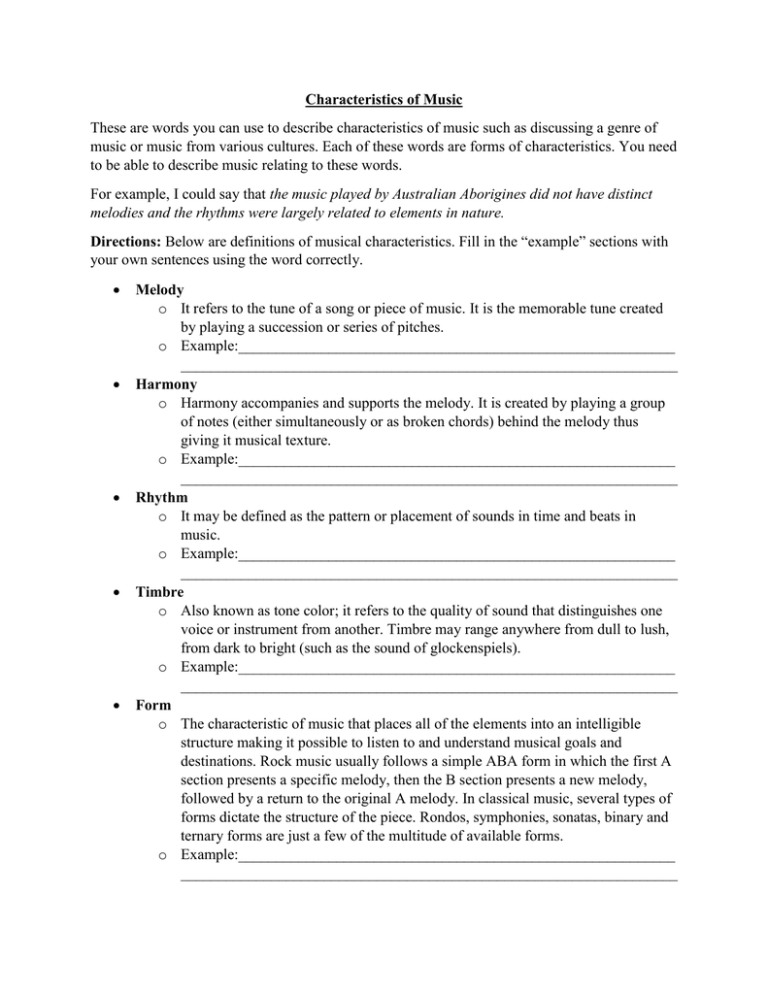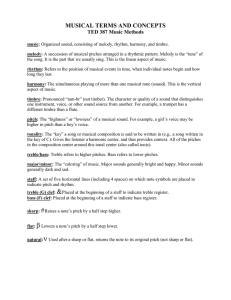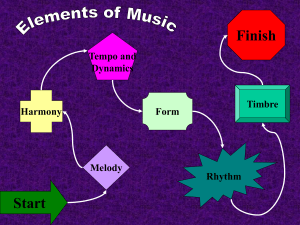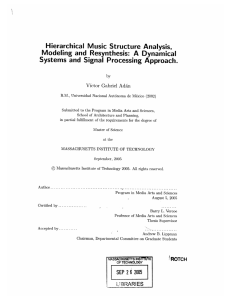Characteristics of Music These are words you can use to describe
advertisement

Characteristics of Music These are words you can use to describe characteristics of music such as discussing a genre of music or music from various cultures. Each of these words are forms of characteristics. You need to be able to describe music relating to these words. For example, I could say that the music played by Australian Aborigines did not have distinct melodies and the rhythms were largely related to elements in nature. Directions: Below are definitions of musical characteristics. Fill in the “example” sections with your own sentences using the word correctly. Melody o It refers to the tune of a song or piece of music. It is the memorable tune created by playing a succession or series of pitches. o Example:__________________________________________________________ __________________________________________________________________ Harmony o Harmony accompanies and supports the melody. It is created by playing a group of notes (either simultaneously or as broken chords) behind the melody thus giving it musical texture. o Example:__________________________________________________________ __________________________________________________________________ Rhythm o It may be defined as the pattern or placement of sounds in time and beats in music. o Example:__________________________________________________________ __________________________________________________________________ Timbre o Also known as tone color; it refers to the quality of sound that distinguishes one voice or instrument from another. Timbre may range anywhere from dull to lush, from dark to bright (such as the sound of glockenspiels). o Example:__________________________________________________________ __________________________________________________________________ Form o The characteristic of music that places all of the elements into an intelligible structure making it possible to listen to and understand musical goals and destinations. Rock music usually follows a simple ABA form in which the first A section presents a specific melody, then the B section presents a new melody, followed by a return to the original A melody. In classical music, several types of forms dictate the structure of the piece. Rondos, symphonies, sonatas, binary and ternary forms are just a few of the multitude of available forms. o Example:__________________________________________________________ __________________________________________________________________ Musical Instruments and Voice o Musical instruments are classified as percussion, strings, woodwinds, brass and keyboards. Another method of classifying musical instruments according to the type of vibrating material used to produce sound is called the Sachs-Hornbostel System. Our voice is also considered a musical instrument. Each of us has a different voice type or vocal range and no two voices are alike. o Example:__________________________________________________________ __________________________________________________________________ Tempo o Indicates how slow or fast the piece should be played. o Example:__________________________________________________________ __________________________________________________________________ Pitch o The relative lowness or highness that we hear in a sound. The pitch of a sound is based on the frequency of vibration and the size of the vibrating object. The slower the vibration and the bigger the vibrating object, the lower the pitch; the faster the vibration and the smaller the vibrating object, the higher the pitch. o Example:__________________________________________________________ __________________________________________________________________ Music Notation o Refers to the symbols used to represent music when writing it down. These symbols specify the pitch, rhythm and meter of a piece of music. o Example:__________________________________________________________ __________________________________________________________________ Beat o Beats give music its regular rhythmic pattern. Beats are grouped together in a measure; the notes and rests corresponds to a certain number of beats. o Example:__________________________________________________________ __________________________________________________________________ Meter o Meter refers to rhythmic patterns produced by grouping together strong and weak beats. Meter may be in duple (2 beats in a measure), triple (3 beats in a measure), quadruple (4 beats in a measure) and so on. o Example:__________________________________________________________ __________________________________________________________________ Dynamics o Dynamics are abbreviations or symbols used to signify the degree of loudness or softness of a piece of music. It also indicates whether there is a change in volume. o Example:__________________________________________________________ __________________________________________________________________








